Cross-Cultural Communication: Ethical Dilemmas and Strategies
VerifiedAdded on 2023/01/11
|13
|3070
|21
Essay
AI Summary
This essay delves into the multifaceted realm of cross-cultural communication (CCC), emphasizing its critical role in the success of businesses operating across diverse cultural landscapes. It highlights the significance of CCC in advertising, illustrating how companies leverage it to connect with clients globally and optimize sales. The essay examines the fundamental elements of CCC, including verbal and non-verbal communication, and underscores the importance of training employees in effective cross-cultural interaction. It then explores ethical dilemmas that can arise from poor CCC, using beer advertising as a case study, and proposes strategies to address these challenges. The essay covers the importance of understanding cultural nuances, the impact of advertising on societal norms, and the necessity of ethical marketing practices. It stresses the role of governments in establishing policies to address ethical issues in advertising and the importance of consumer education. Furthermore, it discusses the role of CCC in promoting teamwork, innovation, and knowledge sharing within international business environments, concluding with a call for businesses to prioritize ethical communication strategies to foster global success.

Running Head: CROSS-CULTURAL COMMUNICATION
Cross-Cultural Communication
Name
Institution
Cross-Cultural Communication
Name
Institution
Paraphrase This Document
Need a fresh take? Get an instant paraphrase of this document with our AI Paraphraser

CROSS-CULTURAL COMMUNICATION 2
Cross-Cultural Communication
Executive Summary
Cross-cultural communication has become an important element of success of many
companies operating in different cultures. Cross-cultural communication has been found to play
a primary role in promoting the business through advertising. Companies use advertising to
communicate with its clients across different cultures that their businesses are located. It has
been established that that businesses that advertise optimize their sales along with profits because
of the promotion and widening their customer base. Many companies are undertaking rigorous
training and education and training to its employees to embrace cross-cultural communication to
ensure that there is effective communication. Cross-cultural communication (CCC) entails verbal
or non-verbal communication that happens between individuals from diverse cultures. This form
of communication will involve two persons from different cultural backgrounds. Governments
should develop policies and practices that will address the current ethical dilemmas in beer
advertising. In addition, education and training are important in creating awareness among the
consumers in the way to making appropriate decisions on messages regarding beer advertising.
The paper will examine the elements of cross-cultural communication, ethical dilemma and
strategies to address the ethical dilemma.
Cross-Cultural Communication
Executive Summary
Cross-cultural communication has become an important element of success of many
companies operating in different cultures. Cross-cultural communication has been found to play
a primary role in promoting the business through advertising. Companies use advertising to
communicate with its clients across different cultures that their businesses are located. It has
been established that that businesses that advertise optimize their sales along with profits because
of the promotion and widening their customer base. Many companies are undertaking rigorous
training and education and training to its employees to embrace cross-cultural communication to
ensure that there is effective communication. Cross-cultural communication (CCC) entails verbal
or non-verbal communication that happens between individuals from diverse cultures. This form
of communication will involve two persons from different cultural backgrounds. Governments
should develop policies and practices that will address the current ethical dilemmas in beer
advertising. In addition, education and training are important in creating awareness among the
consumers in the way to making appropriate decisions on messages regarding beer advertising.
The paper will examine the elements of cross-cultural communication, ethical dilemma and
strategies to address the ethical dilemma.

CROSS-CULTURAL COMMUNICATION 3
Table of Contents
Executive Summary.........................................................................................................................2
Introduction......................................................................................................................................4
Cross-Cultural Communication.......................................................................................................4
Elements of Cross-Cultural Communication...............................................................................5
Importance of Cross-Cultural Communication to Business........................................................6
Ethical Dilemma that can Result from Poor CCC.......................................................................8
Beer Advertising as an Ethical Dilemma.....................................................................................9
Strategies to Address Ethical Dilemma.........................................................................................10
Conclusions....................................................................................................................................11
References......................................................................................................................................12
Table of Contents
Executive Summary.........................................................................................................................2
Introduction......................................................................................................................................4
Cross-Cultural Communication.......................................................................................................4
Elements of Cross-Cultural Communication...............................................................................5
Importance of Cross-Cultural Communication to Business........................................................6
Ethical Dilemma that can Result from Poor CCC.......................................................................8
Beer Advertising as an Ethical Dilemma.....................................................................................9
Strategies to Address Ethical Dilemma.........................................................................................10
Conclusions....................................................................................................................................11
References......................................................................................................................................12
⊘ This is a preview!⊘
Do you want full access?
Subscribe today to unlock all pages.

Trusted by 1+ million students worldwide
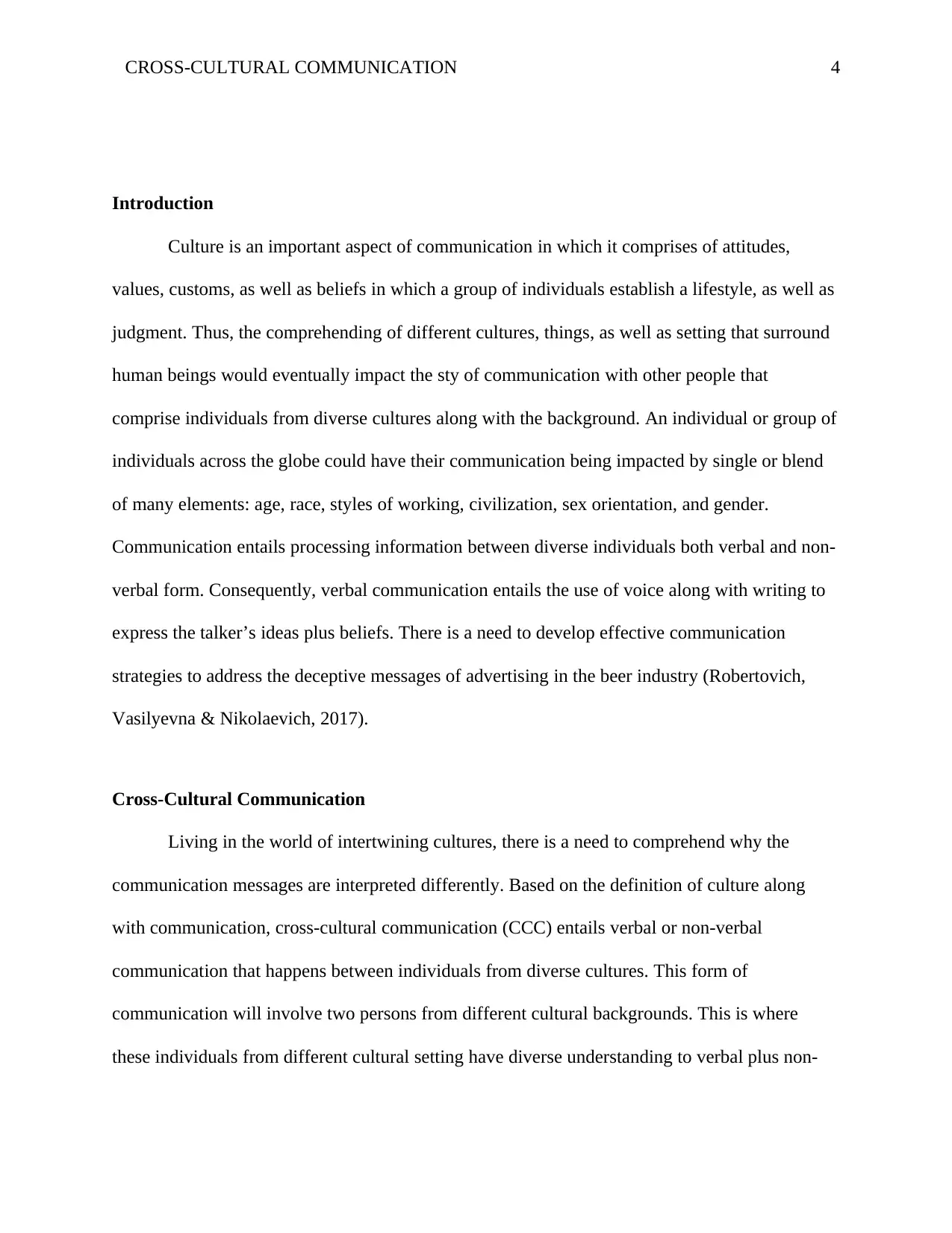
CROSS-CULTURAL COMMUNICATION 4
Introduction
Culture is an important aspect of communication in which it comprises of attitudes,
values, customs, as well as beliefs in which a group of individuals establish a lifestyle, as well as
judgment. Thus, the comprehending of different cultures, things, as well as setting that surround
human beings would eventually impact the sty of communication with other people that
comprise individuals from diverse cultures along with the background. An individual or group of
individuals across the globe could have their communication being impacted by single or blend
of many elements: age, race, styles of working, civilization, sex orientation, and gender.
Communication entails processing information between diverse individuals both verbal and non-
verbal form. Consequently, verbal communication entails the use of voice along with writing to
express the talker’s ideas plus beliefs. There is a need to develop effective communication
strategies to address the deceptive messages of advertising in the beer industry (Robertovich,
Vasilyevna & Nikolaevich, 2017).
Cross-Cultural Communication
Living in the world of intertwining cultures, there is a need to comprehend why the
communication messages are interpreted differently. Based on the definition of culture along
with communication, cross-cultural communication (CCC) entails verbal or non-verbal
communication that happens between individuals from diverse cultures. This form of
communication will involve two persons from different cultural backgrounds. This is where
these individuals from different cultural setting have diverse understanding to verbal plus non-
Introduction
Culture is an important aspect of communication in which it comprises of attitudes,
values, customs, as well as beliefs in which a group of individuals establish a lifestyle, as well as
judgment. Thus, the comprehending of different cultures, things, as well as setting that surround
human beings would eventually impact the sty of communication with other people that
comprise individuals from diverse cultures along with the background. An individual or group of
individuals across the globe could have their communication being impacted by single or blend
of many elements: age, race, styles of working, civilization, sex orientation, and gender.
Communication entails processing information between diverse individuals both verbal and non-
verbal form. Consequently, verbal communication entails the use of voice along with writing to
express the talker’s ideas plus beliefs. There is a need to develop effective communication
strategies to address the deceptive messages of advertising in the beer industry (Robertovich,
Vasilyevna & Nikolaevich, 2017).
Cross-Cultural Communication
Living in the world of intertwining cultures, there is a need to comprehend why the
communication messages are interpreted differently. Based on the definition of culture along
with communication, cross-cultural communication (CCC) entails verbal or non-verbal
communication that happens between individuals from diverse cultures. This form of
communication will involve two persons from different cultural backgrounds. This is where
these individuals from different cultural setting have diverse understanding to verbal plus non-
Paraphrase This Document
Need a fresh take? Get an instant paraphrase of this document with our AI Paraphraser

CROSS-CULTURAL COMMUNICATION 5
verbal messages being communicated at a given context. Thus, the verbal messages usually
express meaning clearer as compared to non-verbal messages (Abugre & Debrah, 2019).
Nevertheless, even a PepsiCo slogan promoted in last 1960s may have been
communicating diverse meaning to individuals who have dissimilar cultures. Thus, the
catchphrase, “come alive, come alive, you are in the Pepsi generation”, bring diverse meanings
to individuals who residing in America, Germany in addition to China that have different
cultures. In addition, in America, the slogan is referring to lifestyle full of vigour. In Germany,
the catchphrase that represent “Come alive out of the grave with Pepsi”. In China, the jingle is
more to be the courier of pleasure. Furthermore, the non-verbal communication is immense
impediment that harmfully impacts the developing of cross-cultural communication in addition
to globalization (Shaw, Barry, Issa, Catley & Muntean, 2016). The eye contact is usually
demonstrating the confidence along with respect to each other in the face-to-face conversing in
many cultures plus nations. Nonetheless, in certain culture, among Aboriginals in Australia,
looking at other’s eyes could be taken as being irrespective along with distasteful in the in person
discussion. Because speedy developments of business, technology in addition to the Internet,
CCC is becoming considerably significant. The case of Pepsi advert slogan demonstrates the lack
of understanding the importance of CCC towards effective communication while dealing with
diverse cultures in the business environment. The case shows that importance of organization of
adopting effective CCC strategies to understand the different cultures across the world to
succeed in their business in reaching out their clients successfully (Robertovich et al., 2017).
Elements of Cross-Cultural Communication
verbal messages being communicated at a given context. Thus, the verbal messages usually
express meaning clearer as compared to non-verbal messages (Abugre & Debrah, 2019).
Nevertheless, even a PepsiCo slogan promoted in last 1960s may have been
communicating diverse meaning to individuals who have dissimilar cultures. Thus, the
catchphrase, “come alive, come alive, you are in the Pepsi generation”, bring diverse meanings
to individuals who residing in America, Germany in addition to China that have different
cultures. In addition, in America, the slogan is referring to lifestyle full of vigour. In Germany,
the catchphrase that represent “Come alive out of the grave with Pepsi”. In China, the jingle is
more to be the courier of pleasure. Furthermore, the non-verbal communication is immense
impediment that harmfully impacts the developing of cross-cultural communication in addition
to globalization (Shaw, Barry, Issa, Catley & Muntean, 2016). The eye contact is usually
demonstrating the confidence along with respect to each other in the face-to-face conversing in
many cultures plus nations. Nonetheless, in certain culture, among Aboriginals in Australia,
looking at other’s eyes could be taken as being irrespective along with distasteful in the in person
discussion. Because speedy developments of business, technology in addition to the Internet,
CCC is becoming considerably significant. The case of Pepsi advert slogan demonstrates the lack
of understanding the importance of CCC towards effective communication while dealing with
diverse cultures in the business environment. The case shows that importance of organization of
adopting effective CCC strategies to understand the different cultures across the world to
succeed in their business in reaching out their clients successfully (Robertovich et al., 2017).
Elements of Cross-Cultural Communication
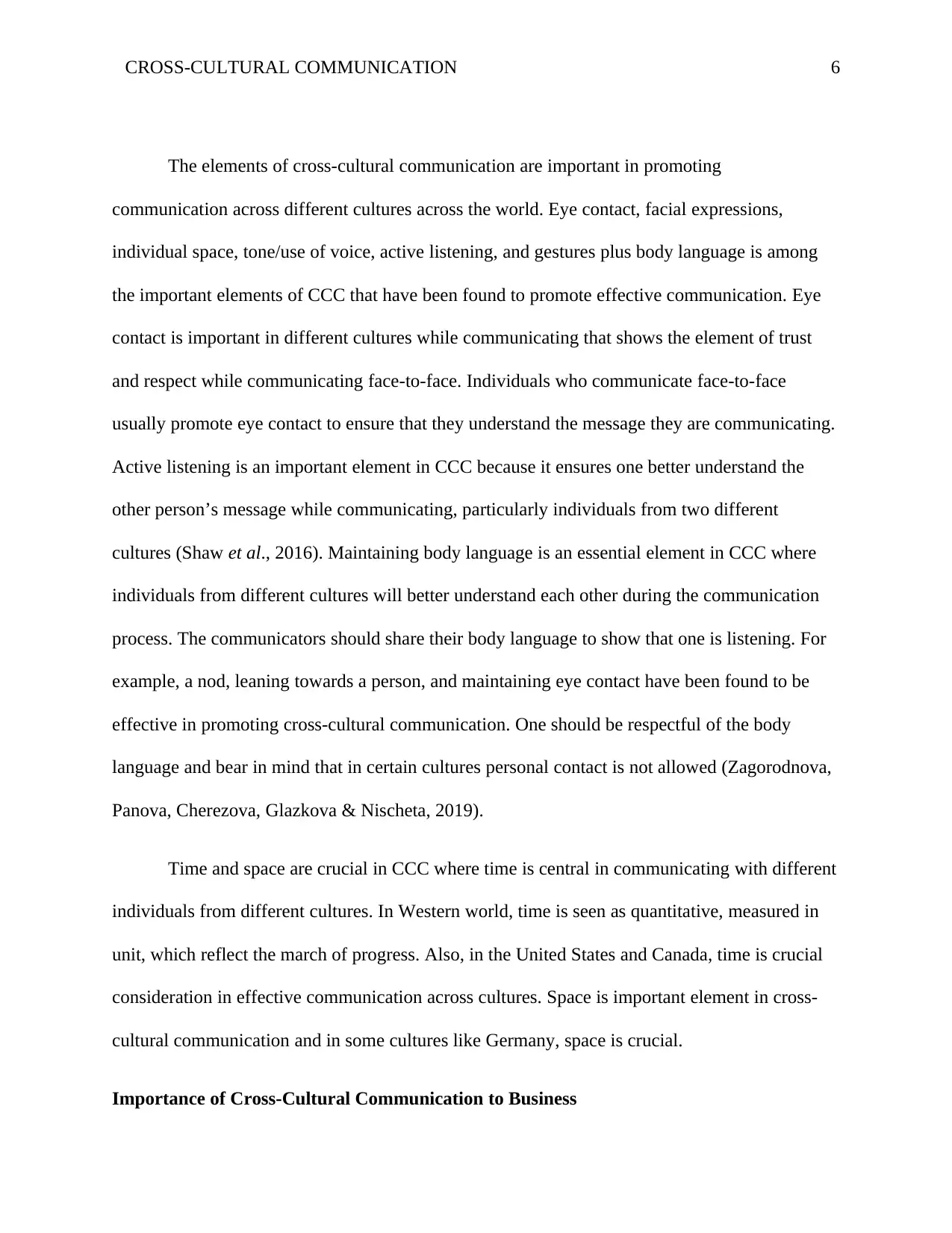
CROSS-CULTURAL COMMUNICATION 6
The elements of cross-cultural communication are important in promoting
communication across different cultures across the world. Eye contact, facial expressions,
individual space, tone/use of voice, active listening, and gestures plus body language is among
the important elements of CCC that have been found to promote effective communication. Eye
contact is important in different cultures while communicating that shows the element of trust
and respect while communicating face-to-face. Individuals who communicate face-to-face
usually promote eye contact to ensure that they understand the message they are communicating.
Active listening is an important element in CCC because it ensures one better understand the
other person’s message while communicating, particularly individuals from two different
cultures (Shaw et al., 2016). Maintaining body language is an essential element in CCC where
individuals from different cultures will better understand each other during the communication
process. The communicators should share their body language to show that one is listening. For
example, a nod, leaning towards a person, and maintaining eye contact have been found to be
effective in promoting cross-cultural communication. One should be respectful of the body
language and bear in mind that in certain cultures personal contact is not allowed (Zagorodnova,
Panova, Cherezova, Glazkova & Nischeta, 2019).
Time and space are crucial in CCC where time is central in communicating with different
individuals from different cultures. In Western world, time is seen as quantitative, measured in
unit, which reflect the march of progress. Also, in the United States and Canada, time is crucial
consideration in effective communication across cultures. Space is important element in cross-
cultural communication and in some cultures like Germany, space is crucial.
Importance of Cross-Cultural Communication to Business
The elements of cross-cultural communication are important in promoting
communication across different cultures across the world. Eye contact, facial expressions,
individual space, tone/use of voice, active listening, and gestures plus body language is among
the important elements of CCC that have been found to promote effective communication. Eye
contact is important in different cultures while communicating that shows the element of trust
and respect while communicating face-to-face. Individuals who communicate face-to-face
usually promote eye contact to ensure that they understand the message they are communicating.
Active listening is an important element in CCC because it ensures one better understand the
other person’s message while communicating, particularly individuals from two different
cultures (Shaw et al., 2016). Maintaining body language is an essential element in CCC where
individuals from different cultures will better understand each other during the communication
process. The communicators should share their body language to show that one is listening. For
example, a nod, leaning towards a person, and maintaining eye contact have been found to be
effective in promoting cross-cultural communication. One should be respectful of the body
language and bear in mind that in certain cultures personal contact is not allowed (Zagorodnova,
Panova, Cherezova, Glazkova & Nischeta, 2019).
Time and space are crucial in CCC where time is central in communicating with different
individuals from different cultures. In Western world, time is seen as quantitative, measured in
unit, which reflect the march of progress. Also, in the United States and Canada, time is crucial
consideration in effective communication across cultures. Space is important element in cross-
cultural communication and in some cultures like Germany, space is crucial.
Importance of Cross-Cultural Communication to Business
⊘ This is a preview!⊘
Do you want full access?
Subscribe today to unlock all pages.

Trusted by 1+ million students worldwide
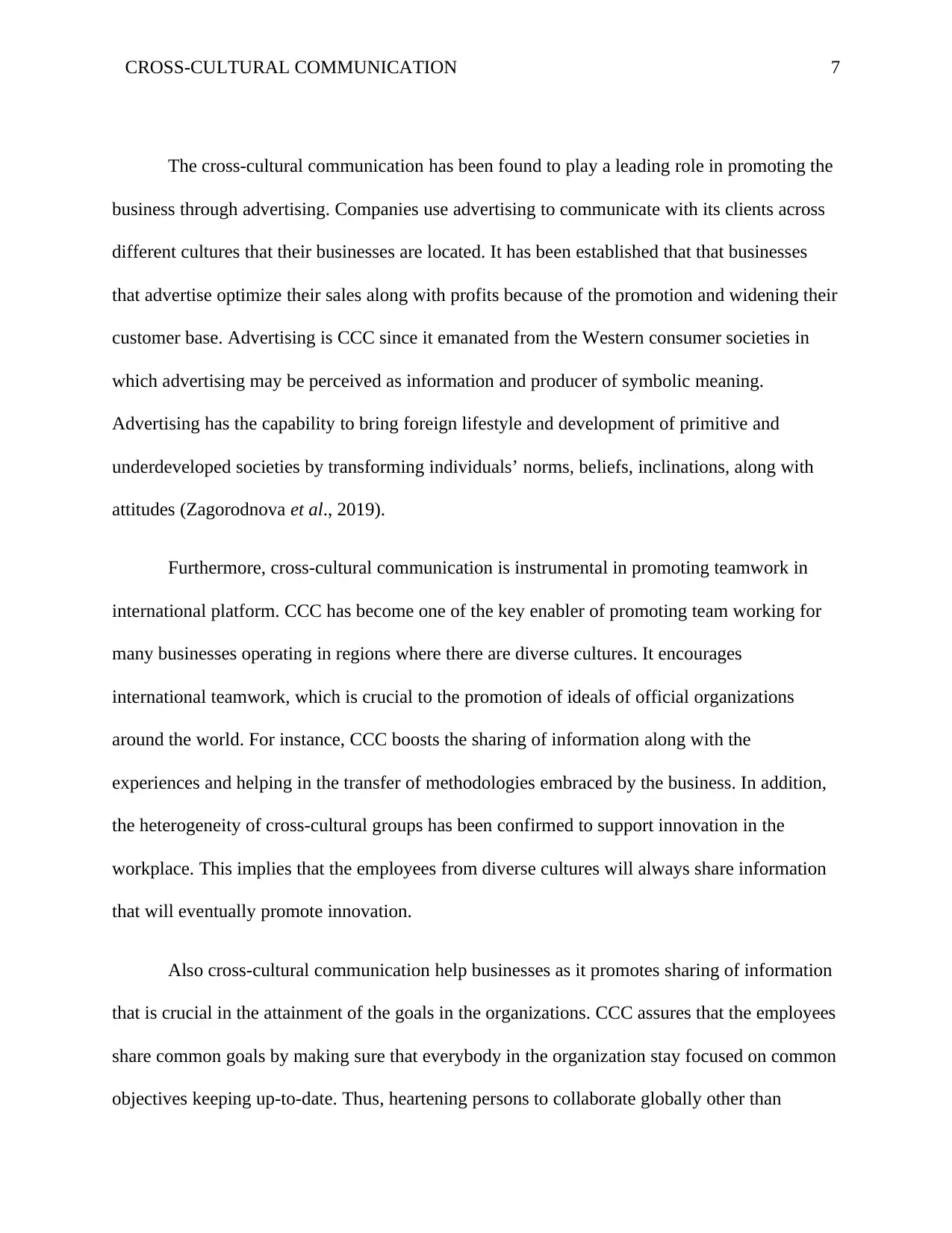
CROSS-CULTURAL COMMUNICATION 7
The cross-cultural communication has been found to play a leading role in promoting the
business through advertising. Companies use advertising to communicate with its clients across
different cultures that their businesses are located. It has been established that that businesses
that advertise optimize their sales along with profits because of the promotion and widening their
customer base. Advertising is CCC since it emanated from the Western consumer societies in
which advertising may be perceived as information and producer of symbolic meaning.
Advertising has the capability to bring foreign lifestyle and development of primitive and
underdeveloped societies by transforming individuals’ norms, beliefs, inclinations, along with
attitudes (Zagorodnova et al., 2019).
Furthermore, cross-cultural communication is instrumental in promoting teamwork in
international platform. CCC has become one of the key enabler of promoting team working for
many businesses operating in regions where there are diverse cultures. It encourages
international teamwork, which is crucial to the promotion of ideals of official organizations
around the world. For instance, CCC boosts the sharing of information along with the
experiences and helping in the transfer of methodologies embraced by the business. In addition,
the heterogeneity of cross-cultural groups has been confirmed to support innovation in the
workplace. This implies that the employees from diverse cultures will always share information
that will eventually promote innovation.
Also cross-cultural communication help businesses as it promotes sharing of information
that is crucial in the attainment of the goals in the organizations. CCC assures that the employees
share common goals by making sure that everybody in the organization stay focused on common
objectives keeping up-to-date. Thus, heartening persons to collaborate globally other than
The cross-cultural communication has been found to play a leading role in promoting the
business through advertising. Companies use advertising to communicate with its clients across
different cultures that their businesses are located. It has been established that that businesses
that advertise optimize their sales along with profits because of the promotion and widening their
customer base. Advertising is CCC since it emanated from the Western consumer societies in
which advertising may be perceived as information and producer of symbolic meaning.
Advertising has the capability to bring foreign lifestyle and development of primitive and
underdeveloped societies by transforming individuals’ norms, beliefs, inclinations, along with
attitudes (Zagorodnova et al., 2019).
Furthermore, cross-cultural communication is instrumental in promoting teamwork in
international platform. CCC has become one of the key enabler of promoting team working for
many businesses operating in regions where there are diverse cultures. It encourages
international teamwork, which is crucial to the promotion of ideals of official organizations
around the world. For instance, CCC boosts the sharing of information along with the
experiences and helping in the transfer of methodologies embraced by the business. In addition,
the heterogeneity of cross-cultural groups has been confirmed to support innovation in the
workplace. This implies that the employees from diverse cultures will always share information
that will eventually promote innovation.
Also cross-cultural communication help businesses as it promotes sharing of information
that is crucial in the attainment of the goals in the organizations. CCC assures that the employees
share common goals by making sure that everybody in the organization stay focused on common
objectives keeping up-to-date. Thus, heartening persons to collaborate globally other than
Paraphrase This Document
Need a fresh take? Get an instant paraphrase of this document with our AI Paraphraser

CROSS-CULTURAL COMMUNICATION 8
working only in their home nations, assists the business make sure that all of its associates are
sharing knowledge. Sharing knowledge is important in the modern business environment
because the shared information will increase the productivity of the employees boosting the
profitability in the organization. Furthermore, CCC helps to allow the members share experience
that will benefit the business. The employees will leverage knowledge of the global teams that
will benefit the business. A team with diverse skills will generally outperform teams that do not
have skills or unable to coordinate appropriately (Qili & Dong, 2016).
Ethical Dilemma
Ethical dilemma is a decision-making between two probable moral imperatives, neither
of which unmistakably acceptable or preferable. The complexity emanates of the situational
conflict in which obeying one could lead to transgressing another. There are three primary
conditions, which should be present for a condition to be taken as ethical dilemma. The primary
condition happens in situations where a person (agent) should make a decision regarding the
course of act is most excellent. Consequently, the second condition for ethical dilemma is that
there should be different in an ethical dilemma, regardless of the course of action to choose from.
Finally, an ethical dilemma regardless what route of action is considered; some ethical standard
is compromised (Dolgoff, Lowenberg & Harrington, 2009).
Ethical Dilemma that can Result from Poor CCC
Marketing is the skill of delivering value while ethical marketing is designed to offer this
value via what is ethically right. The new era clients are knowledgeable and less prone to
unethical practices plus cannot be simply swayed by messages from marketers. Nonetheless, the
working only in their home nations, assists the business make sure that all of its associates are
sharing knowledge. Sharing knowledge is important in the modern business environment
because the shared information will increase the productivity of the employees boosting the
profitability in the organization. Furthermore, CCC helps to allow the members share experience
that will benefit the business. The employees will leverage knowledge of the global teams that
will benefit the business. A team with diverse skills will generally outperform teams that do not
have skills or unable to coordinate appropriately (Qili & Dong, 2016).
Ethical Dilemma
Ethical dilemma is a decision-making between two probable moral imperatives, neither
of which unmistakably acceptable or preferable. The complexity emanates of the situational
conflict in which obeying one could lead to transgressing another. There are three primary
conditions, which should be present for a condition to be taken as ethical dilemma. The primary
condition happens in situations where a person (agent) should make a decision regarding the
course of act is most excellent. Consequently, the second condition for ethical dilemma is that
there should be different in an ethical dilemma, regardless of the course of action to choose from.
Finally, an ethical dilemma regardless what route of action is considered; some ethical standard
is compromised (Dolgoff, Lowenberg & Harrington, 2009).
Ethical Dilemma that can Result from Poor CCC
Marketing is the skill of delivering value while ethical marketing is designed to offer this
value via what is ethically right. The new era clients are knowledgeable and less prone to
unethical practices plus cannot be simply swayed by messages from marketers. Nonetheless, the
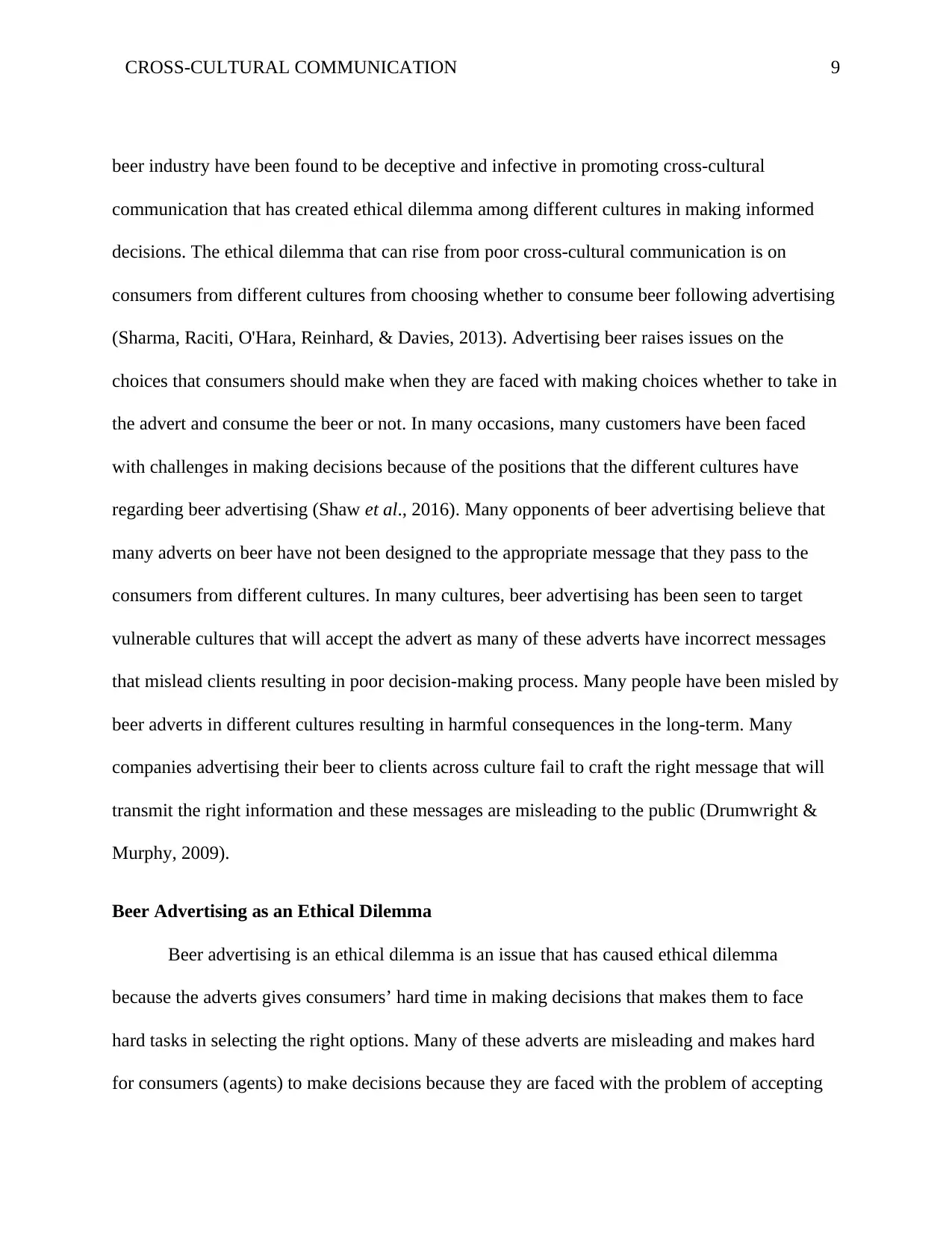
CROSS-CULTURAL COMMUNICATION 9
beer industry have been found to be deceptive and infective in promoting cross-cultural
communication that has created ethical dilemma among different cultures in making informed
decisions. The ethical dilemma that can rise from poor cross-cultural communication is on
consumers from different cultures from choosing whether to consume beer following advertising
(Sharma, Raciti, O'Hara, Reinhard, & Davies, 2013). Advertising beer raises issues on the
choices that consumers should make when they are faced with making choices whether to take in
the advert and consume the beer or not. In many occasions, many customers have been faced
with challenges in making decisions because of the positions that the different cultures have
regarding beer advertising (Shaw et al., 2016). Many opponents of beer advertising believe that
many adverts on beer have not been designed to the appropriate message that they pass to the
consumers from different cultures. In many cultures, beer advertising has been seen to target
vulnerable cultures that will accept the advert as many of these adverts have incorrect messages
that mislead clients resulting in poor decision-making process. Many people have been misled by
beer adverts in different cultures resulting in harmful consequences in the long-term. Many
companies advertising their beer to clients across culture fail to craft the right message that will
transmit the right information and these messages are misleading to the public (Drumwright &
Murphy, 2009).
Beer Advertising as an Ethical Dilemma
Beer advertising is an ethical dilemma is an issue that has caused ethical dilemma
because the adverts gives consumers’ hard time in making decisions that makes them to face
hard tasks in selecting the right options. Many of these adverts are misleading and makes hard
for consumers (agents) to make decisions because they are faced with the problem of accepting
beer industry have been found to be deceptive and infective in promoting cross-cultural
communication that has created ethical dilemma among different cultures in making informed
decisions. The ethical dilemma that can rise from poor cross-cultural communication is on
consumers from different cultures from choosing whether to consume beer following advertising
(Sharma, Raciti, O'Hara, Reinhard, & Davies, 2013). Advertising beer raises issues on the
choices that consumers should make when they are faced with making choices whether to take in
the advert and consume the beer or not. In many occasions, many customers have been faced
with challenges in making decisions because of the positions that the different cultures have
regarding beer advertising (Shaw et al., 2016). Many opponents of beer advertising believe that
many adverts on beer have not been designed to the appropriate message that they pass to the
consumers from different cultures. In many cultures, beer advertising has been seen to target
vulnerable cultures that will accept the advert as many of these adverts have incorrect messages
that mislead clients resulting in poor decision-making process. Many people have been misled by
beer adverts in different cultures resulting in harmful consequences in the long-term. Many
companies advertising their beer to clients across culture fail to craft the right message that will
transmit the right information and these messages are misleading to the public (Drumwright &
Murphy, 2009).
Beer Advertising as an Ethical Dilemma
Beer advertising is an ethical dilemma is an issue that has caused ethical dilemma
because the adverts gives consumers’ hard time in making decisions that makes them to face
hard tasks in selecting the right options. Many of these adverts are misleading and makes hard
for consumers (agents) to make decisions because they are faced with the problem of accepting
⊘ This is a preview!⊘
Do you want full access?
Subscribe today to unlock all pages.

Trusted by 1+ million students worldwide

CROSS-CULTURAL COMMUNICATION 10
the adverts and the option of not accepting the adverts. Many of the companies manufacturing
beers will craft messages to the consumers in a manner that makes hard to make decisions and
these messages are deceitful. The messages targeting consumers have been designed in a manner
that does not mention the adverse effects of beer. Recently, there have been increased cases of
road accidents, social aggression, as well as health related use of alcoholic drinks. The
consumers are faced with the problem of choosing pleasures over the consequences of taking
beer based on the advertisements. In many cultures, many firms tend to take advantage and
exploit clients who are ignorant in order to boost their sales and make more profits (Sharma et
al., 2013).
In many instances, these consumers are influenced circuitously from pressure from peers
in addition to organizations that automatically influence their minds along with the purchase
decisions. These acts have been found to affect the decision-making process because of poorly
designed cross- cultural communication that has made it hard for some consumers to reject
messages and fall prey of the advertisements because of poor communication process. The
companies are motivated by profits and not the interest of the clients who consume the product.
This has continued to cause more harms to the members of the society who are vulnerable and
cannot make informed decisions as they cannot successfully interpret the messages by the
advertising agencies on beer. Therefore, the failure to develop effective cross-cultural
communication (CCC) would ultimately result in ethical dilemma because clients cannot make
the right choices.
Strategies to Address Ethical Dilemma
the adverts and the option of not accepting the adverts. Many of the companies manufacturing
beers will craft messages to the consumers in a manner that makes hard to make decisions and
these messages are deceitful. The messages targeting consumers have been designed in a manner
that does not mention the adverse effects of beer. Recently, there have been increased cases of
road accidents, social aggression, as well as health related use of alcoholic drinks. The
consumers are faced with the problem of choosing pleasures over the consequences of taking
beer based on the advertisements. In many cultures, many firms tend to take advantage and
exploit clients who are ignorant in order to boost their sales and make more profits (Sharma et
al., 2013).
In many instances, these consumers are influenced circuitously from pressure from peers
in addition to organizations that automatically influence their minds along with the purchase
decisions. These acts have been found to affect the decision-making process because of poorly
designed cross- cultural communication that has made it hard for some consumers to reject
messages and fall prey of the advertisements because of poor communication process. The
companies are motivated by profits and not the interest of the clients who consume the product.
This has continued to cause more harms to the members of the society who are vulnerable and
cannot make informed decisions as they cannot successfully interpret the messages by the
advertising agencies on beer. Therefore, the failure to develop effective cross-cultural
communication (CCC) would ultimately result in ethical dilemma because clients cannot make
the right choices.
Strategies to Address Ethical Dilemma
Paraphrase This Document
Need a fresh take? Get an instant paraphrase of this document with our AI Paraphraser
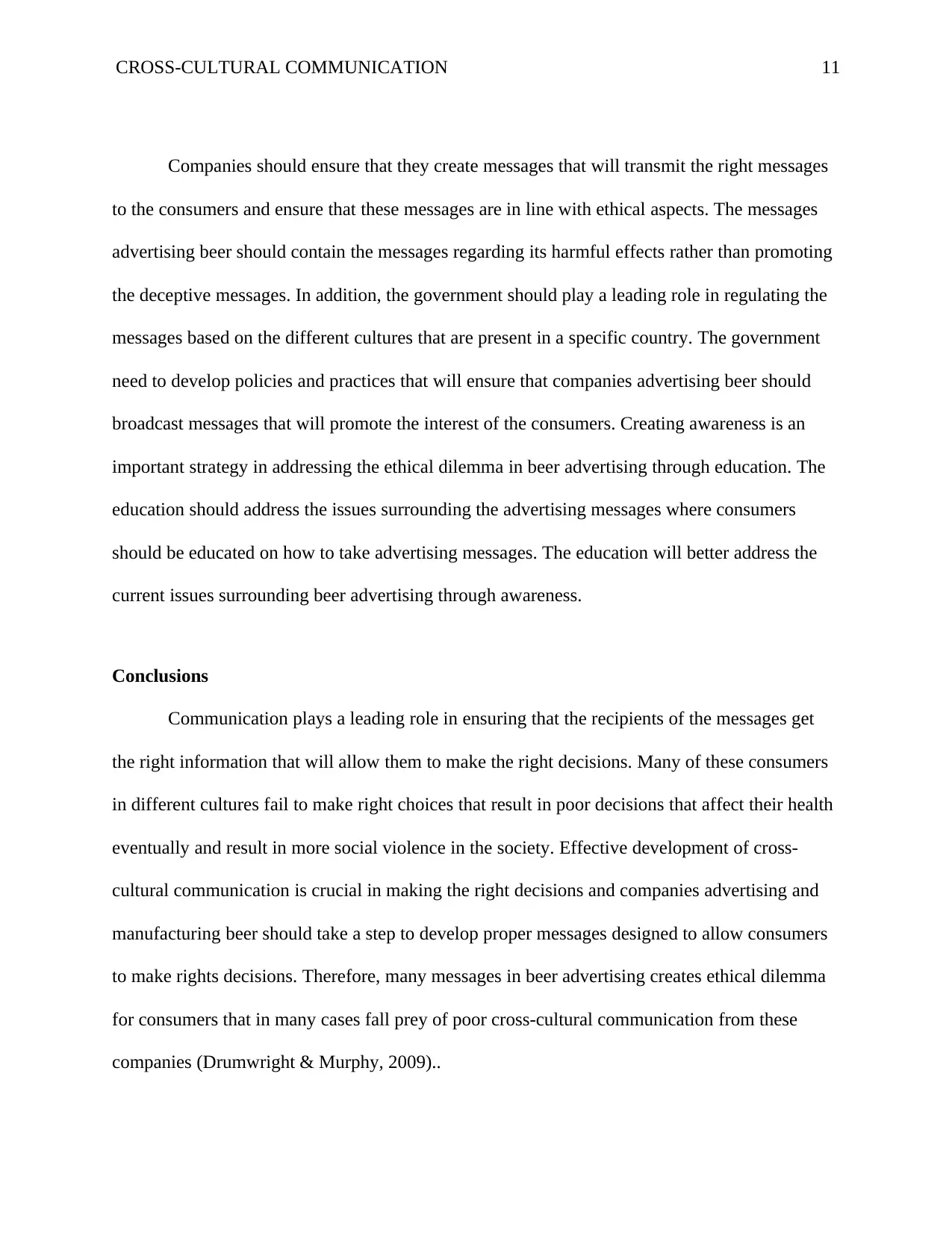
CROSS-CULTURAL COMMUNICATION 11
Companies should ensure that they create messages that will transmit the right messages
to the consumers and ensure that these messages are in line with ethical aspects. The messages
advertising beer should contain the messages regarding its harmful effects rather than promoting
the deceptive messages. In addition, the government should play a leading role in regulating the
messages based on the different cultures that are present in a specific country. The government
need to develop policies and practices that will ensure that companies advertising beer should
broadcast messages that will promote the interest of the consumers. Creating awareness is an
important strategy in addressing the ethical dilemma in beer advertising through education. The
education should address the issues surrounding the advertising messages where consumers
should be educated on how to take advertising messages. The education will better address the
current issues surrounding beer advertising through awareness.
Conclusions
Communication plays a leading role in ensuring that the recipients of the messages get
the right information that will allow them to make the right decisions. Many of these consumers
in different cultures fail to make right choices that result in poor decisions that affect their health
eventually and result in more social violence in the society. Effective development of cross-
cultural communication is crucial in making the right decisions and companies advertising and
manufacturing beer should take a step to develop proper messages designed to allow consumers
to make rights decisions. Therefore, many messages in beer advertising creates ethical dilemma
for consumers that in many cases fall prey of poor cross-cultural communication from these
companies (Drumwright & Murphy, 2009)..
Companies should ensure that they create messages that will transmit the right messages
to the consumers and ensure that these messages are in line with ethical aspects. The messages
advertising beer should contain the messages regarding its harmful effects rather than promoting
the deceptive messages. In addition, the government should play a leading role in regulating the
messages based on the different cultures that are present in a specific country. The government
need to develop policies and practices that will ensure that companies advertising beer should
broadcast messages that will promote the interest of the consumers. Creating awareness is an
important strategy in addressing the ethical dilemma in beer advertising through education. The
education should address the issues surrounding the advertising messages where consumers
should be educated on how to take advertising messages. The education will better address the
current issues surrounding beer advertising through awareness.
Conclusions
Communication plays a leading role in ensuring that the recipients of the messages get
the right information that will allow them to make the right decisions. Many of these consumers
in different cultures fail to make right choices that result in poor decisions that affect their health
eventually and result in more social violence in the society. Effective development of cross-
cultural communication is crucial in making the right decisions and companies advertising and
manufacturing beer should take a step to develop proper messages designed to allow consumers
to make rights decisions. Therefore, many messages in beer advertising creates ethical dilemma
for consumers that in many cases fall prey of poor cross-cultural communication from these
companies (Drumwright & Murphy, 2009)..
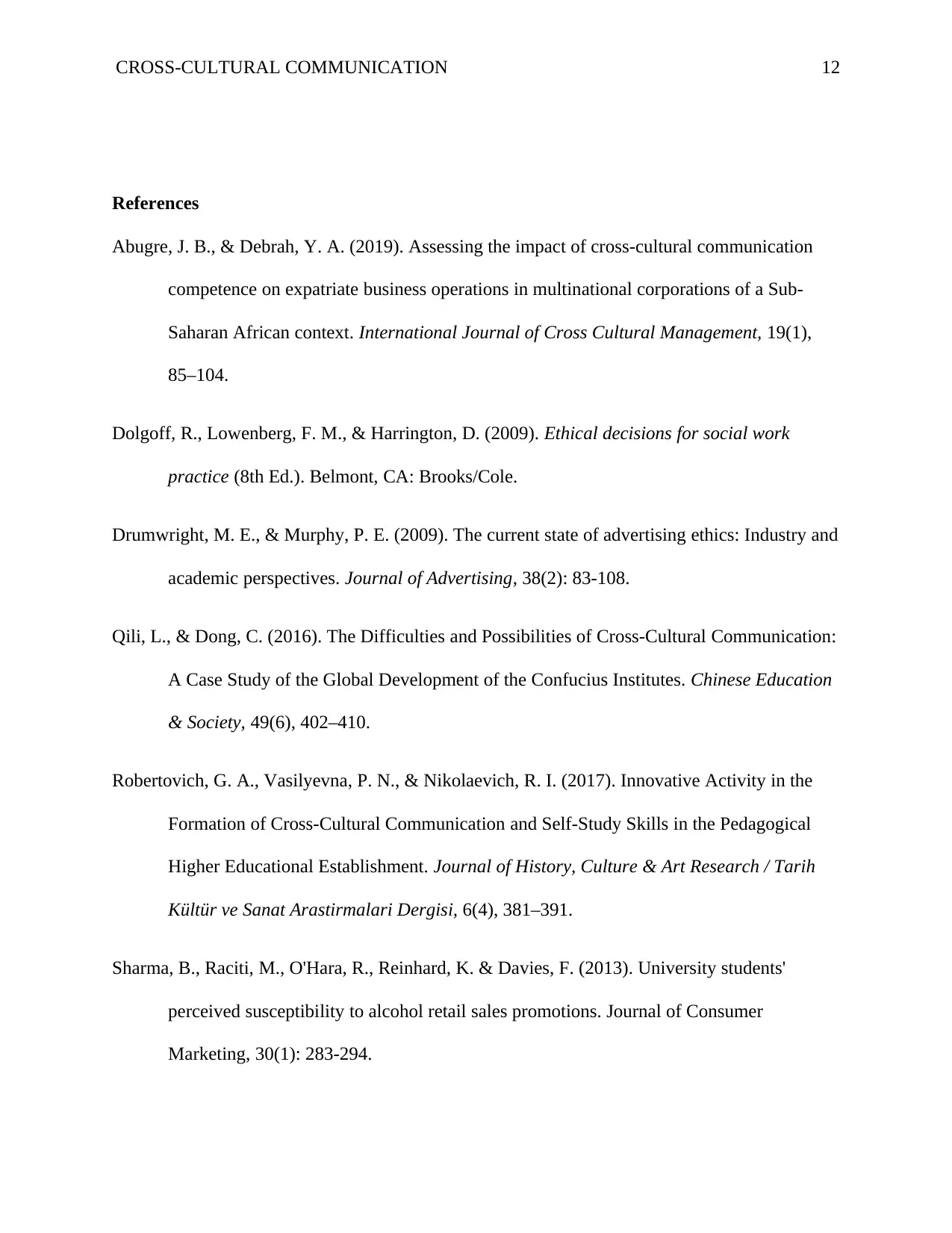
CROSS-CULTURAL COMMUNICATION 12
References
Abugre, J. B., & Debrah, Y. A. (2019). Assessing the impact of cross-cultural communication
competence on expatriate business operations in multinational corporations of a Sub-
Saharan African context. International Journal of Cross Cultural Management, 19(1),
85–104.
Dolgoff, R., Lowenberg, F. M., & Harrington, D. (2009). Ethical decisions for social work
practice (8th Ed.). Belmont, CA: Brooks/Cole.
Drumwright, M. E., & Murphy, P. E. (2009). The current state of advertising ethics: Industry and
academic perspectives. Journal of Advertising, 38(2): 83-108.
Qili, L., & Dong, C. (2016). The Difficulties and Possibilities of Cross-Cultural Communication:
A Case Study of the Global Development of the Confucius Institutes. Chinese Education
& Society, 49(6), 402–410.
Robertovich, G. A., Vasilyevna, P. N., & Nikolaevich, R. I. (2017). Innovative Activity in the
Formation of Cross-Cultural Communication and Self-Study Skills in the Pedagogical
Higher Educational Establishment. Journal of History, Culture & Art Research / Tarih
Kültür ve Sanat Arastirmalari Dergisi, 6(4), 381–391.
Sharma, B., Raciti, M., O'Hara, R., Reinhard, K. & Davies, F. (2013). University students'
perceived susceptibility to alcohol retail sales promotions. Journal of Consumer
Marketing, 30(1): 283-294.
References
Abugre, J. B., & Debrah, Y. A. (2019). Assessing the impact of cross-cultural communication
competence on expatriate business operations in multinational corporations of a Sub-
Saharan African context. International Journal of Cross Cultural Management, 19(1),
85–104.
Dolgoff, R., Lowenberg, F. M., & Harrington, D. (2009). Ethical decisions for social work
practice (8th Ed.). Belmont, CA: Brooks/Cole.
Drumwright, M. E., & Murphy, P. E. (2009). The current state of advertising ethics: Industry and
academic perspectives. Journal of Advertising, 38(2): 83-108.
Qili, L., & Dong, C. (2016). The Difficulties and Possibilities of Cross-Cultural Communication:
A Case Study of the Global Development of the Confucius Institutes. Chinese Education
& Society, 49(6), 402–410.
Robertovich, G. A., Vasilyevna, P. N., & Nikolaevich, R. I. (2017). Innovative Activity in the
Formation of Cross-Cultural Communication and Self-Study Skills in the Pedagogical
Higher Educational Establishment. Journal of History, Culture & Art Research / Tarih
Kültür ve Sanat Arastirmalari Dergisi, 6(4), 381–391.
Sharma, B., Raciti, M., O'Hara, R., Reinhard, K. & Davies, F. (2013). University students'
perceived susceptibility to alcohol retail sales promotions. Journal of Consumer
Marketing, 30(1): 283-294.
⊘ This is a preview!⊘
Do you want full access?
Subscribe today to unlock all pages.

Trusted by 1+ million students worldwide
1 out of 13
Related Documents
Your All-in-One AI-Powered Toolkit for Academic Success.
+13062052269
info@desklib.com
Available 24*7 on WhatsApp / Email
![[object Object]](/_next/static/media/star-bottom.7253800d.svg)
Unlock your academic potential
Copyright © 2020–2025 A2Z Services. All Rights Reserved. Developed and managed by ZUCOL.



